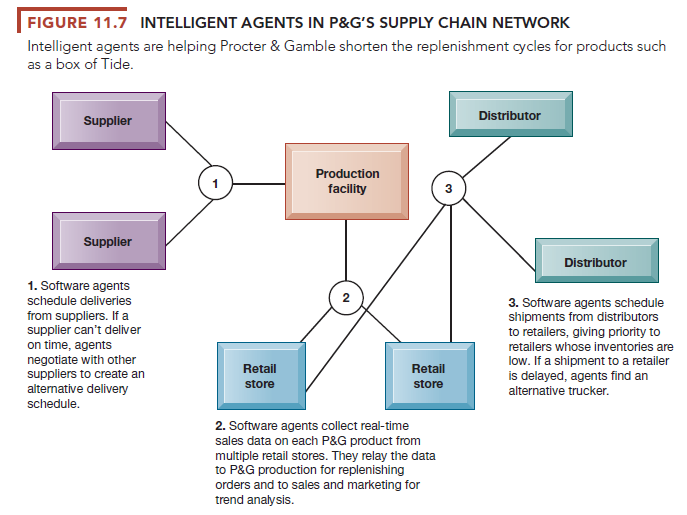Firms must deal with at least three kinds of knowledge. Some knowledge exists within the firm in the form of structured text documents (reports and presentations). Decision makers also need knowledge that is semistructured, such as email, voice mail, chat room exchanges, videos, digital pictures, brochures, or bulletin board postings. In still other cases, there is no formal or digital information of any kind, and the knowledge resides in the heads of employees. Much of this knowledge is tacit knowledge that is rarely written down. Enterprise-wide knowledge management systems deal with all three types of knowledge.

1. Enterprise Content Management Systems
Businesses today need to organize and manage both structured and semistructured knowledge assets. Structured knowledge is explicit knowledge that exists in formal documents as well as in formal rules that organizations derive by observing experts and their decision-making behaviors. But according to experts, at least 80 percent of an organization’s business content is semistructured or unstructured-information in folders, messages, memos, proposals, emails, graphics, electronic slide presentations, and even videos created in different formats and stored in many locations.
Enterprise content management (ECM) systems help organizations manage both types of information. They have capabilities for knowledge capture, storage, retrieval, distribution, and preservation to help firms improve their business processes and decisions. Such systems include corporate repositories of documents, reports, presentations, and best practices, as well as capabilities for collecting and organizing semistructured knowledge such as email (see Figure 11.8). Major enterprise content management systems also enable users to access external sources of information, such as news feeds and research, and to communicate via email, chat/instant messaging, discussion groups, and videoconferencing. They are starting to incorporate blogs, wikis, and other enterprise social networking tools. Open Text Corporation, IBM, and Oracle are leading vendors of enterprise content management software.

A key problem in managing knowledge is the creation of an appropriate classification scheme, or taxonomy, to organize information into meaningful categories so that it can be easily accessed. Once the categories for classifying knowledge have been created, each knowledge object needs to be “tagged,” or classified, so that it can be easily retrieved. Enterprise content management systems have capabilities for tagging, interfacing with corporate databases and content repositories, and creating enterprise knowledge portals that provide a single point of access to information resources.
Firms in publishing, advertising, broadcasting, and entertainment have special needs for storing and managing unstructured digital data such as photographs, graphic images, video, and audio content. For example, Coca-Cola must keep track of all the images of the Coca-Cola brand that have been created in the past at all of the company’s worldwide offices to prevent both redundant work and variation from a standard brand image. Digital asset management systems help companies classify, store, and distribute these digital objects.
2. Locating and Sharing Expertise
Some of the knowledge businesses need is not in the form of a digital document but instead resides in the memory of individual experts in the firm. Contemporary enterprise content management systems, along with the systems for collaboration and social business introduced in Chapter 2, have capabilities for locating experts and tapping their knowledge. These include online directories of corporate experts and their profiles with details about their job experience, projects, publications, and educational degrees, and repositories of expert-generated content. Specialized search tools make it easier for employees to find the appropriate expert in a company. For knowledge resources outside the firm, social networking and social business tools enable users to bookmark web pages of interest, tag these bookmarks with keywords, and share the tags and web page links with other people.
3. Learning Management Systems
Companies need ways to keep track of and manage employee learning and to integrate it more fully into their knowledge management and other corporate systems. A learning management system (LMS) provides tools for the management, delivery, tracking, and assessment of various types of employee learning and training.
Contemporary LMS support multiple modes of learning, including CD-ROM, downloadable videos, web-based classes, live instruction in classes or online, and group learning in online forums and chat sessions. The LMS consolidates mixed-media training, automates the selection and administration of courses, assembles and delivers learning content, and measures learning effectiveness. The Interactive Session on Management shows how Sargent & Lundy used learning management and enterprise collaboration systems to increase sharing of employee expertise and employee learning.
Businesses run their own learning management systems, but they are also turning to publicly available massive open online courses (MOOCs) to educate their employees. A MOOC is an online course made available via the web to very large numbers of participants. Companies view MOOCs as a new way to design and deliver online learning where learners can collaborate with each other, watch short videos, and participate in threaded discussion groups. Firms such as Microsoft, AT&T, and Tenaris have developed their own MOOCs, while others such as Bank of America and Qualcomm are adapting publicly available MOOCs aligned with their core competencies.
Source: Laudon Kenneth C., Laudon Jane Price (2020), Management Information Systems: Managing the Digital Firm, Pearson; 16th edition.

I envy your work, thanks for all the good blog posts.